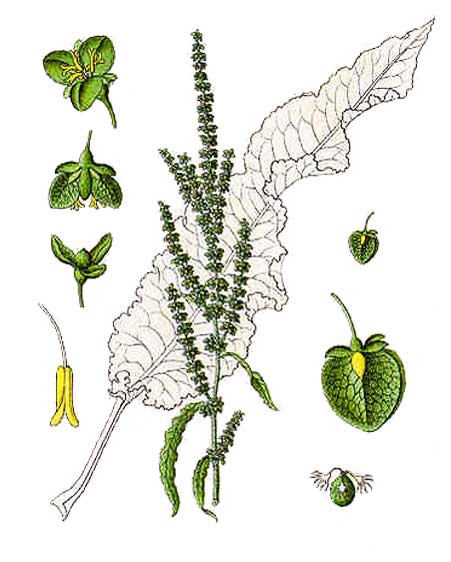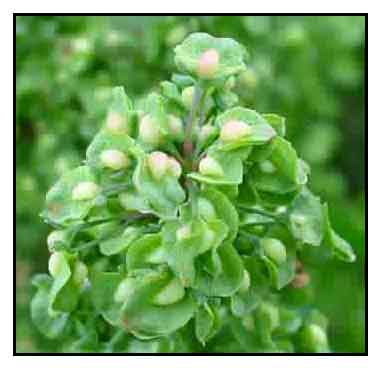|
Botany
Curly dock is an erect, simple
and sparingly branched plant, growing to a height of 30 to 90
centimeters. Leaves are variable in shape, the lower leaves, oblong to
oblong-lanceolate, 1.5 to 30 centimeters long, the upper leaves narrowly
oblong or lanceolate, 8 to 16 centimeters long, with either sharp or obtuse apex, and rounded at the base. Panicles are rather dense and not leafy. Valves are entire, usually tubercles number 3. Achene is oblong-ovoid,
2 millimeter long.
 Distribution Distribution
- Recently introduced
to the Benguet area; sparingly naturalized at altitudes of 1,400
to 2,200 meters.
- Native of Europe and now a widely distributed weed in temperate countries.
Constituents
- Roots contain 0.2% and the twigs a trace of oxymethyl-anthraquinone.
- Dried
root yields 0.1% of emodin, and slightly less of chrysophanic acid.
- Plant has yielded tannic acid.
- Also yields oxalic acid and rumicin, a tasteless, golden-yellow substance, which is irritant and has been used to destroy skin parasites.
- Root yields anthraquinone and calcium oxalate; the leaves yield emodin and brassidinic acid.
- Anthraquinones identified include nepodin, chrysophanol, physcion, emodin, chrysophanic acid, and rhein.
- Flavanoid compounds identified: quercitrin and quercetin.
- Yields minerals: iron, sodium, potassium, magnesium and calcium.
- Study yielded 15 compounds: beta-sitosterol(1), hexadecanoic acid(2), hexadecanoic-2,3-dihydroxy propyleste(3), chrysophanol(4), physcion(5), emodin(6), chrysophanol-8-O-beta-D-glucopyranoside(7), physcion-8-O-beta-D-glucopyranoside(8), emodin-8O-beta-D-glucopyranoside(9), gallic acid(10), (+)-catechin(11), kaempferol(12), quercetin(13), kaempferol-3-O-alpha-L-rhamnopyranoside(14), quercetin-3-O-alpha-L-rhamnopyranoside(15). (9)
Properties
- Root is mildly purgative and astringent, tonic and febrifuge.
- Plant traditionally used as 'blood purifier,' tonic and astringent.
- Alterative, antiscorbutic, depurative, laxative, tonic.
Parts
utilized
Leaves, roots and rhizome.
Uses
Edibility
- Young leaves reportedly used as vegetable.
- See report of fatal poisoning. (Below: Caution / Study)
Folkloric
- Root decoction used for fevers.
- Fresh bruised roots for skin ailments, dermatitis and skin rashes.
- Root decoction used for jaundice, constipation, psoriasis; laxative
effect attributed to anthraquinone.
- Also used to stimulate bile production.
- Liver problems and arthritis.
- Used for acute and chronic inflammation of nasal passages.
- Used as treatment for tapeworms and roundworms.
- For vascular disorders and internal bleeding.
- Applied externally to ulcers, boils and tumors.
- Roots and seeds used for nausea, chronic dysentery, and hepatic disorders.
- Decoction of roots for purgative effect and liver problems.
- In Indo-China, root decoction used for intermittent fevers.
- In India, roots and seeds used as dentifrice; also used for chronic dysentery, nausea, and hepatic disorders. (15)
Homeopathy
- Used in the treatment of severe respiratory affections of the larynx, trachea, and bronchi. Used for pneumonia and consumption; for dry, incessant, violent and non-productive coughing.
(19)
Others
Sometimes referred to as "poor man's ginseng."
 Studies Studies
• Antioxidant / Antimicrobial: Study of Rumex crispus showed highest antioxidant
activities with the extracts of leaves and seeds. The ether extracts
of both leaves and seeds and the ethanol extract of leaves showed antimicrobial
activities against S aureus and B subtilis. (4)
• Antimicrobial: In an evaluation of four medicinal plants for antimicrobial activities, the acetone extracts of the roots of Rumex crispus and A rotundifolius demonstrated significant inhibitory effects against most of the test microorganisms ( S aureus, B subtilis, A hydrophylla, K pneumonia, P aeruginosa and C albicans).
• Phenolic Content
/ Antioxidant / Antibacterial: Study showed the aerial part to have a high
phenolic content and antioxidant activity. The methanolic extract possessed
strong antibacterial activity against Agrogacterium tumefaciens, B cereus,
B subtilis, Pseudomonas corrugate, Pseudomonas syringae, Salmonella
typhimurium, Serratia liquefaciens, V cholera, among others.
Study suggests the aerial part of RC can be used as an effective and
safe source of antioxidants and antibacterial agent. (5)
•
Antioxidant / Antimicrobial / Leaves and Seeds: Study showed the antioxidant activities increased with increasing amount of extracts. The water extracts showed of the leaves and seeds showed the highest antioxidant activities. The ether extracts of leaves and seeds and the ethanol extract of leaves showed antimicrobial activity against S aureus and B subtilis. (6)
• Anti-Leishmanial / Antimicrobial Activity: Six plants with known antimicrobial activity, including Rumex crispus,were screened for inhibition of the protozoal parasite, Leishmania mexicana. The ethanol and DMSO extracts exhibited varying degrees of inhibition against L mexicana. They also caused growth inhibition of several food-borne pathogens and bacteria. (7)
• Anticancer Compounds / Roots: Study showed evidence of toxic compounds in the root of Rumex crispus with the potential to have anti-cancer activity. The study focused on preliminary survey of in vitro effects of root extracts on human colon adenocarcinoma cell line. (11)
• Biomass Effect on Barley Grain Germination: Study investigated the allelopathic-phytotoxic effects of R. crispus on spring barley germination in laboratory experiments. Results showed grounded seed biomass had a significant stimulation effect on spring barley grain germination. (14)
• Fatal Poisoning Report: A case of fatal poisoning is reported attributed to ingestion of Rumex crispus plant material. The patient presented with gastrointestinal symptoms, severe hypocalcemia, metabolic acidosis, and acute hepatic insufficiency. The report emphasizes the risk in using the plant for culinary and medicinal purposes. (16)
• Angelicin / Herbicidal: Study isolated a herbicidally active compound from curly dock. The ECDA fraction was determined as angelicin: 2H-furo[2,3-H]-[1]-benzopyran-2-one. Angelicin was evaluated o barnyard grass, southern crabgrass and indian jointvetch. Results suggest angelicin could be used as lead compound in the development of new herbicides. (17)
• Antioxidant / Antimicrobial / Essential Oils: Study showed the essential oils of R. crispus and R. cristatus exhibited important antioxidant and antimicrobial activity. (18)
Caution
!
• Because of
high oxalic content, leaves should not be eaten in large amounts.
• Case of Fatal Poisoning: Young leaves must be boiled to remove the oxalate content; deaths
have been reported
after consuming uncooked leaves for medicinal purposes. (see study above) (16)
• Because of oxalate content, should be avoided in those with
kidney stones, rheumatism, gout.
• Probably unsafe in pregnancy because of anthraquinone content.
• Anthraquinone is secreted in breast milk, and therefore a concern
for breast feeding mothers.
Availability
Wild-crafted.
Supplements, extracts, teas, oils and pellets in the cybermarket. |



![]()

